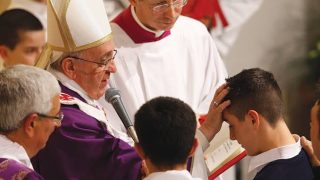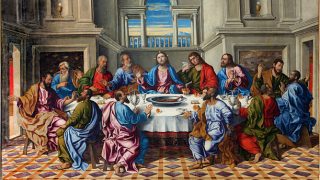
THE NATURE OF GOD AND THE BEST COMMUNITY
SOLEMNITY OF THE MOST HOLY TRINITY, YEAR A. Readings: Exodus 34:4-6, 8-9; Responsorial: Daniel 3:52-56; 2 Corinthians 13:11-13 and John 3:16-18.
In those days, religious divisions came from conflicting beliefs about God, rather than any conflict between theism and atheism. This division has caused many to look keenly to the nature of God. Among the ‘many’ was Arius who fell into heresy, known as the Arian heresy in the fourth century. While attempting to explain the nature of God, he stated, “If the Father Begat the Son, then he who was begotten had a beginning in existence, and from this, it follows there was a time when the Son was not.” Put differently, his heresy was that, Christ was not fully God and unequal with God the Father. This led to the Ecumenical Council of Nicaea of 325 AD where the Church proclaimed the dogma of the Holy Trinity, affirming that the doctrine of the Trinity holds that God the Father, the Son and the Holy Spirit are one God, but three Divine persons.
Biblically, the Old Testament often presents a monotheistic idea of God, who stands as the Father and creator of heaven and earth. With the emergence of Jesus Christ in the New Testament, we understand that God the Father communicate or revealed himself in the Son, otherwise known as auto-communication/self-revelation of God; Hebrew 1:1 says, “In the past, God spoke to our ancestors through the prophets at many times and in various ways, in our time, He has spoken to us through His Son.” This is visible from His incarnation to ascension. After the ascension of the Son, the Holy Spirit, which is the sanctifier and the third person of the Blessed Trinity, celebrated last week (Pentecost Sunday), was revealed to us as God. Christ in various instances reveals to us the unity and oneness of the Trinity. He said to his disciples, “All that the father has belongs to me” (Jn 16:18); He said to Philip, “I and the father are one” (Jn 14:10); In John 16:13, he said, “When the Spirit of truth comes, he will lead you to the complete truth.” In John 8:38 Christ said, “I tell you, before Abraham ever was, I AM,” which reminds us of the revelation of God the Father to Moses at the burning bush (I AM who I am). Hence, we can claim that our knowledge of the Trinity begins from Christ. It is Christocentric. That is, the feast of the Holy Trinity is the liturgical conclusion, which begins from advent, Christmas and cumulate on Pentecost Sunday. Put differently, in Christ is the fullness of God’s revelation.
However, If man can fully comprehend God, then God is no longer God. The Holy Trinity we celebrate today is beyond the reach of time and the grasp of human reasoning. Our knowledge as man about God is limited. That is why the Holy Trinity remains a mystery to us and this mystery is the central of our Christian faith. According to the Catechism of the Catholic Church, “It is the most fundamental and essential teaching in the hierarchy of the truths of faith” (CCC. 234). It is a mystery of our faith. In this mystery, there are three figures, the Father, Son and Holy Spirit. There, the figure three symbolizes completeness and perfect symmetry, and re-appears at all the key moments of God the Son. His life itself constantly reflected the Trinity. Three figures make up the nativity scene in Bethlehem, the Holy Family of Jesus, Mary and Joseph. Their first visitors were the three wise men. Later, in the desert preparing to begin his public life, the Son was tempted three times by the devil. The end of his life, as the beginning, has again the three motifs. During his Passion, Peter denied him thrice. On the road to Calvary, he fell three times. The crucifixion scene has three figures, Christ between two thieves. Before his resurrection, he spent three days in the tomb. All these events reflect the Holy Trinity, which was revealed to us in different ways.
In the first reading, God the Father, who is also known as the creator of heaven and earth revealed himself to Moses on Mount Sinai as a merciful and gracious Father, who is slow to anger, abounding in love and faithfulness. We were told Moses bowed his head to the earth and worshipped Him. While he worshipped God, he pleaded for mercy upon his people who are sinners and needed redemption.
In the Gospel, God revealed Himself in the Son, “God the Father so love the world, that he gave his only-begotten Son, that whoever believes in him should not perish but have eternal life. For the Father sent the Son into the world, not to condemn the world, but that the world might be saved through him” (Jn 3:16-17). Christ became the new Moses, that through Him, sinners received redemption. The Church teaches that, “Christ revealed that God is Father in an unheard of sense: He is Father not only in being Creator, he is eternally Father in relation to his only Son, who is eternally Son only in relation to his Father: ‘No one knows the Son except the Father, and no one knows the Father except the Son and anyone to whom the Son chooses to reveal him’” (CCC. 240). In this revelation, John 1:1 tells us, “In the beginning was the Word, and the Word was with God, and the Word was God.” John refers to Christ as the Word who was present in the beginning.
From the apostolic tradition, the Council of Nicaea in 325 asserts that, “The Son is ‘consubstantial’ with the Father,” that is, of the same substance or essence with the Father. The essence of the Father is interwoven in the Son. The Council of Constantinople in the year 381 kept this expression in the formulation of the Nicene Creed that the Son, “Is eternal begotten of the Father, light from light, true God from true God, begotten not made, consubstantial with the Father” (242). From the Father and the Son proceeds the Holy Spirit. The Spirit was sent by the Father in the name of the Son, which we experience on Pentecost Sunday to Sanctify the Church, which reveals the fullness of the mystery of the Holy Trinity. This is what St. Paul recognized as he constantly ends most of his letters in the Trinitarian formula as seen in the second reading of today, “The grace of our Lord Jesus Christ, the love of God and the fellowship of the Holy Spirit.”
In a nutshell, the Solemnity of Holy Trinity communicates the life of communion with one another, communion with every nation, tribe, people, language or tongue. The Holy Trinity communicate a uniform race called humanity. In the Holy Trinity, we see a unity that exist and a family of love known as the best community ever. The Father, the Son and the Holy Spirit are inseparable. Despite the distinct role they play, the Father as creator, the Son as redeemer and the Holy Spirit as Sanctifier, they remain one in essence. Hence, our families are good symbol of the Holy Trinity, the father, mother and children may have their distinct role to play in the family, each has his or her autonomy but there should be a bond that unites us, which is the Spirit of God, that is, the love that exist between the Father and the Son. This love strengthens the relationship between parents and children and between spouses. This Spirit will also enable us to love one another for God is love. May God’s name be praised and highly exalted as we say: Glory be to the Father, and to the Son and to the Holy Spirit: As it was in the beginning is now, and ever shall be, world without end. Amen!
Happy Trinity Sunday!
Fr. Ken Dogbo, OSJ









